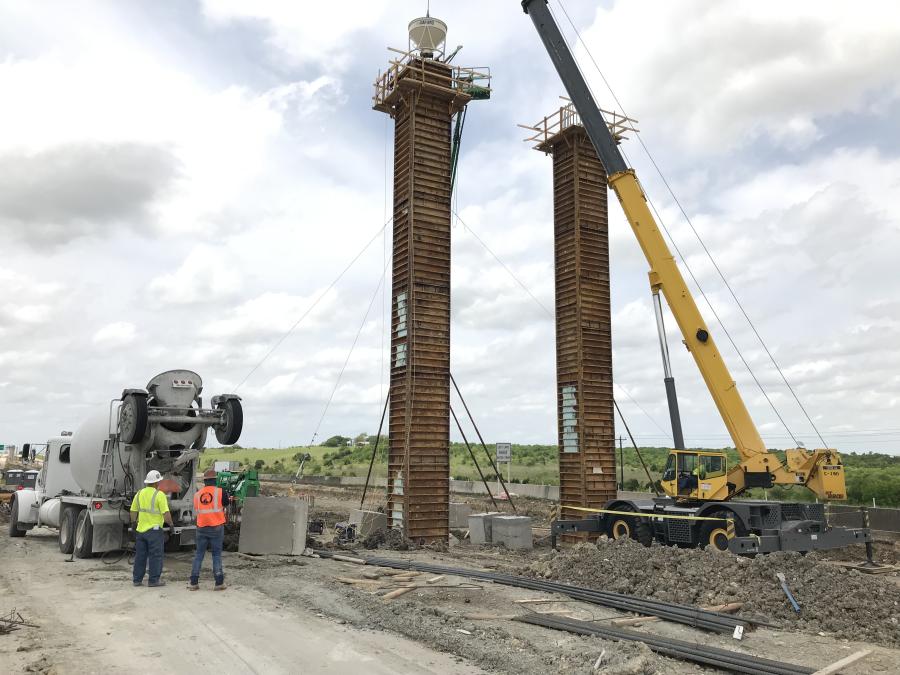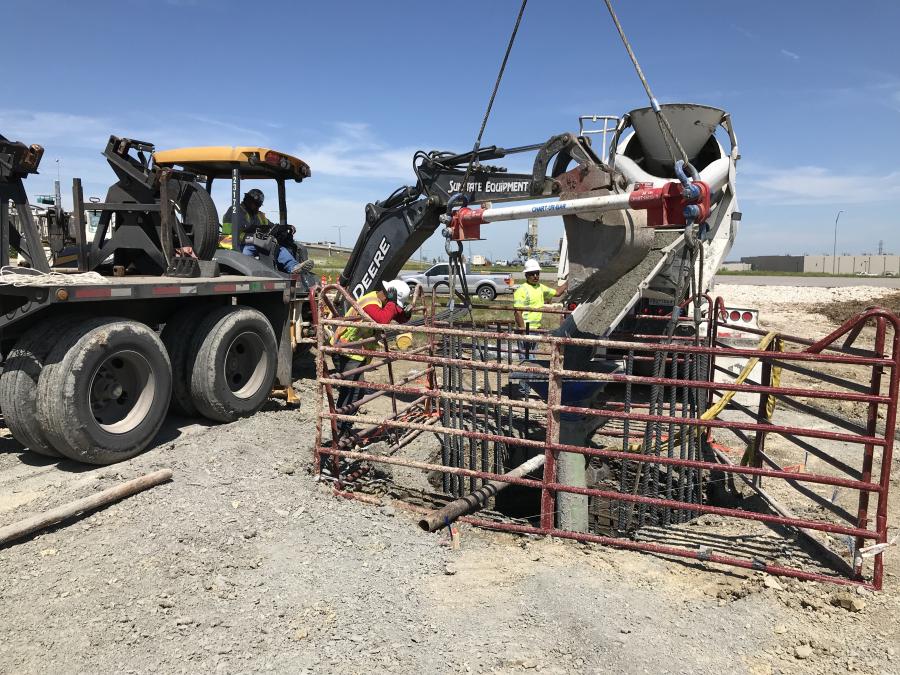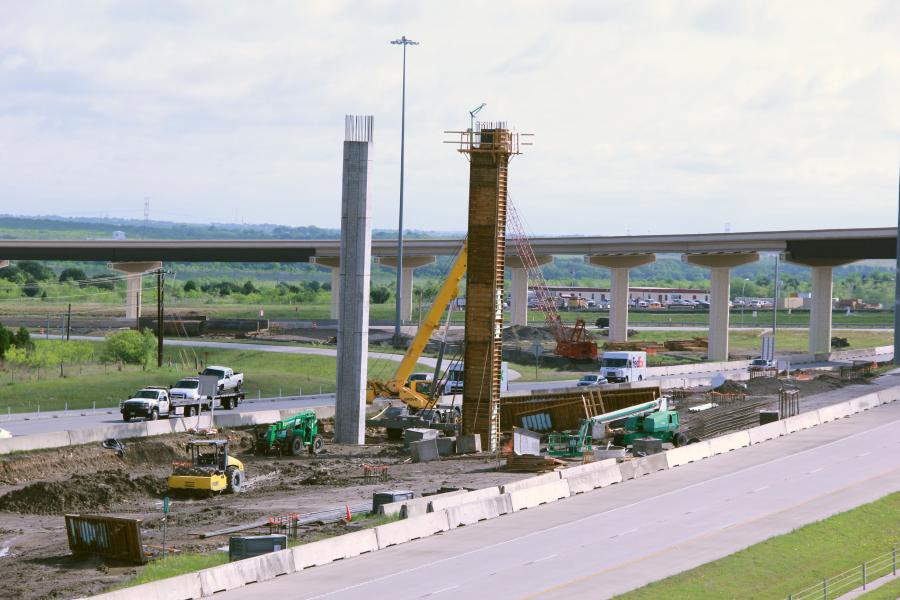The contractor will be excavating approximately 45,000 cu. yds. of material, and embanking 88,000 cu. yds. of material.
(Central Texas Regional Mobility Authority photo)
In an effort to ease congestion, the Central Texas Regional Mobility Authority (CTRMA) and the Texas Department of Transportation (TxDOT) are overseeing construction of three flyovers at the convergence of 290 Toll and SH 130. The $127 million project will link the two roadways.
"Central Texans' reliance on the 290 Toll Road as a convenient travel option created a high demand for the roadway, greater than anticipated," said Mike Heiligenstein, CTRMA executive director. "The number of commuters using the roadway surpassed official projections and led to unsafe traffic congestion at the frontage road intersection of 290 Toll and SH 130.
"Without an efficient link between the two roadways, mobility and safety were compromised during the morning rush hour for southbound SH 130 drivers trying to head westbound on 290 Toll. The new flyovers will provide a free-flowing direct connection between the two facilities, enhancing mobility and safety for all drivers."
According to Heiligenstein, now is the right time to carry out the work.
"There is no time to waste. The Austin region is one of the fastest-growing areas in the country. Economic forecasters say that the metropolitan area may reach 3.2 million people by 2030. The Mobility Authority's primary responsibility is working with its partners to create a carefully planned, proactive transportation system to keep drivers moving."
The Mobility Authority has systems in place to monitor the operational capacities of roadways and uses a best practices approach to plan and build improvements.
"As soon as we saw the congestion problems beginning to occur, we consulted our partners and got moving.
Everyone at the table agreed that our job is to design and build as efficiently as possible to solve traffic congestion problems head on, and that's what we were able to do."
The 290/130 Flyovers Project used innovative approaches and a partnership of administrative resources to deliver project financing and construction which will expedite the project schedule and reduce risk. The project improves access to downtown Austin for communities along the U.S. 290 and SH 130 corridors by providing a safe and efficient link between the two roadways without drivers having to exit the mainlanes and travel through signalized intersections.
"With the majority of through traffic on the main lanes, the frontage roads carry primarily local traffic, thereby reducing congestion and facilitating safer ingress and egress from businesses."
Heiligenstein said it's rewarding to see the progress made since officials first identified the need for improvements.
"Knowing that construction of the ultimate solution to address congestion at this interchange was years away, we constructed an interim improvement project in 2016 that has provided temporary relief for drivers traveling between southbound SH 130 and westbound U.S. 290 into Austin. As the highest volume movement at the interchange, we knew that a temporary solution was needed while we identified funds and completed development of plans for the 290/130 Flyover Project.
"The interim improvements project consisted of the addition of dual right turn lanes on southbound SH130 frontage road, the addition of a southbound through-lane on the frontage road, the extension of the merge of the sweeping right turn, the addition of an extra lane on the westbound entrance ramp to the 290 Toll mainlanes and additional signage. The project was completed in September 2016."
Said Heiligenstein, "Many of our stakeholders comment how fast the work is going, even those who experience the daily inconveniences of driving through construction work zones. We're glad that we are on target to substantially improve two of our most traveled highways."
As for how motorists will be affected, construction activity will occur on U.S. 290/290 Toll from west of Blue Goose Road to Parmer Lane. On SH 130, construction work will occur from north of East Parmer Lane to south of Blue Bluff Road.
"There will be lane closures and traffic shifts from time to time that will be inconvenient. But the contractor operates under strict guidelines, and will make every effort to minimize disruptions for commuters. Overnight lane closures may occur between 9 p.m. and 5 a.m. on weekdays and 5 p.m. to 11 a.m. on weekends. Daytime closures on the mainlanes of 290 Toll and SH 130 also may occur.
"The contractor will face financial penalties if a closure occurs outside of approved time frames. In order to minimize construction noise, the project team will follow a set of guidelines designed to preserve quality of life for adjacent neighborhoods."
Benefits of the flyovers include reducing potential for high-speed rear-end collisions on SH 130, eliminating queuing of vehicles on the southbound and northbound main lanes of SH 130, saving roughly $5 million a year for the traveling public in time, as well as fuel and vehicle costs. The flyovers also are expected to attract more than 5,000 vehicles per day from parallel facilities, providing additional congestion relief to other corridors.
In addition, greenhouse gas emissions will be reduced by 1,020 metric tons annually, and there will likely be economic development opportunities for the region, based on enhanced local and regional connectivity.
Non-tolled drivers also will experience travel benefits from the project. With a free-flowing direct connection on the mainlanes between 290 Toll and SH 130 Toll, fewer drivers will use the frontage road intersection, freeing up capacity and improving traffic flow. Also, projections show that up to 5,000 vehicles per day will be attracted from parallel facilities, providing additional congestion relief on other corridors.
"Due to the strength of the partnership between the Mobility Authority and TxDOT, the entire project is being implemented under a single construction contract administered by the Mobility Authority, as opposed to two separately let projects," said Heiligenstein. "In order to advance the project with no delays, the Mobility Authority secured subordinate lien Bond Anticipation Notes (BANS) while going through the TIFIA loan process.
"The Mobility Authority anticipates refunding all or a portion of the BANS with the loan secured from TIFIA. Those funds, along with the TxDOT contribution that will come from toll revenue from TxDOT's facilities, will facilitate congestion management in an expedited manner made possible by the partnership between agencies. The partnership between TxDOT and the Mobility Authority showcases the expedient delivery possible on a significantly accelerated timeline."
Webber LLC, headquartered in Houston, serves as the project contractor. For crews, the biggest challenge is the fact there are three projects with two different contractors working on major improvements to the intersection. Two of the contracts being managed by one contractor are to widen the SH 130 mainlanes and to build three direct connectors.
Initial work began in late November, 2018, with the goal to have flyovers ready for commuters at the end of 2021. Currently, the contractor is drilling shafts and columns for two of the three flyovers. Heiligenstein said constructing three flyovers at the convergence of 290 Toll and SH 130 is no small task.
"The first step is to remove the grass and topsoil. The next steps are to drill the shafts, construct columns and caps, place beams, form and pour the bridge decks, form and pour concrete rails, construct bridge approaches and retaining walls and sign and stripe the bridges. This project does not have any major excavation work or clearing of right of way, because it is primarily a bridge job."
So far, the weather has had a minimal effect on the overall schedule. There are two milestones on this project, with the first being completion of the south to west direct connector. The second is to substantially complete the project, which entails the contractor having all three of the direct connectors open to traffic and collecting tolls on the SW and NW direct connectors.
The contractor will be excavating approximately 45,000 cu. yds. of material, and embanking 88,000 cu. yds. of material. Main equipment includes three large drill rigs, two excavators, one bulldozer and three cranes. Concrete is the primary material used on the project. Other items will be retaining wall panels and backfill, illumination poles and some sidewalks.
While a number of people have been involved in the planning of the flyovers, former Mobility Authority board member James Mills will be recognized as a true leader on the project.
"He was among the first to identify the need for mobility improvements at the interchange back in 2015," said Mike Heiligenstein. "The north-to-west and south-to-west flyovers will be named in his honor."
CEG
Cindy Riley
Birmingham, Ala., native Cindy RIley originally planned on a career in law, but during her sophomore year in college realized journalism was her true calling. A magna cum laude graduate of Samford University, Riley first worked in radio and TV. Named Best News Anchor, Best News Reporter and Best Investigative Reporter by the Associated Press, she interviewed numerous personalities, ranging from Dr. Henry Kissinger and President Bush to Michael Jordan and Captain Kangaroo.
As a print journalist, Riley has covered a variety of topics, including construction, business, health and the arts. In addition to CEG, her work has appeared in special reports for USA Today and the L.A. Times. Other publications have included New South Magazine, Portico, Thicket, Alabama Heritage, B-Metro, Business First and Birmingham Business Journal.
Read more from Cindy Riley here.
Today's top stories





















